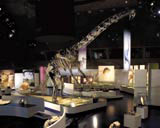Museums take their skills to market
As museum funding keeps falling in real terms, the pressure is on to drum up revenue, says Scott Billings

Professor Tim Molloy, head of strategic design for the Science Museum, is in no doubt over his position. Faced with more than a decade of real-term funding cuts by the Government, the three institutions under his remit – gathered as the National Museum of Science and Industry – must work ever harder to drum up their own cash.
‘We are left with very clear writing on the wall, which says we have to find ways to get funding ourselves. The Government continues to cut museum funding, and quite openly now,’ he says.
The financial squeeze is taking hold at all the national museums. According to Gordon Rankmore, head of design and interpretation at the Natural History Museum, the Department for Culture, Media and Sport is expecting these national institutions to explore all routes that may generate income.
The Victoria & Albert Museum’s commercial arm, V&A Enterprises, this month launches a collection of furniture and products developed in collaboration with homeware retailer Heal’s (DW 3 March). The range will be sold at Heal’s and ties in with the company’s sponsorship of the V&A’s current International Arts and Crafts exhibition.
According to Molloy, their commercial operations are emerging from an earlier period of quiet, almost apologetic money-raising, to a more extensive championing of skills for sale. A major component of these skills lies in design.
Museum teams have many years experience of exhibition design and of communicating to the public, as well as an ability to handle the research and management requirements of putting on a show. For corporate and Governmental clients, these teams can bring a rich source of design skills for staging exhibitions or educational installations. For the museums themselves, such clients offer a revenue stream that can be fed back to the primary purse.
At the Natural History Museum, Rankmore has seen a rising demand for consultancy and collaboration. He decided, 18 months ago, to turn NHM’s consultancy services into a dedicated unit, Planning and Design Consultancy. Over the coming months he is seeking to add five members to the department, building a team with skills in project management, exhibition research and development.
The division is producing a masterplan for a dinosaur attraction in Dubai, under the working title Restless Planet. The attraction will form part of the ambitious Dubailand construction, a key constituent of Dubai Crown Prince Sheikh Mohammed’s scheme to steer the country’s revenue generation away from reliance on oil, and towards tourism.
NHM also worked on the Lost Worlds exhibition in Qatar, organised by the country’s National Council for Culture, Arts and Heritage. The exhibition of extinct life on Earth was created in collaboration with Pentagram and ran for nine weeks, closing last December. However, perhaps the highest-profile project for the museum is the UK Pavilion for the world exposition in Japan (DW 6 May 2004). Created in collaboration with Ten Alps Events and Land Design Studio, the pavilion – called www.my-earth.org.uk – will be revealed at the Expo 2005 launch this Friday.
The exposition’s nature theme uses the museum’s consultancy skills in both academic study and design. Its scientists turned to the animal kingdom to develop a series of innovations, including a swimsuit product for Speedo that imitates the reduced-friction surface found on sharkskin.
The Science Museum’s commercial arm, Science Museum Solutions, also draws on the skills of designers. ‘We have day-to-day practical experience in what it takes to create a visitor experience like a museum,’ says Molloy. ‘Having me as creative director of Solutions means there is a direct connection between the core operations of the Science Museum and the broader commercial world.’
Both Molloy and Rankmore intend to keep their teams small, bringing in specialist consultancies on a project-by-project basis.
Molloy sees the role of museums, and particularly the Science Museum, as increasingly hinged on establishing a dialogue with the public. Issues-based topics are not the typical domain of museums, which have historically taken a one-way, didactic standpoint, centred on the presentation of artefacts.
The design challenge, says Molloy, is to illuminate and communicate ideas, as well as present objects in cases. And importantly, he believes these skills translate well to the commercial world, where corporations may need to engage and educate the public on what they do, while being seen to be editorially impartial.
Within the museum, the Energy Gallery is the best realisation of this approach so far, says Molloy. It was sponsored by BP, which now has a commercial relationship with Solutions, although the museum stipulates full editorial control in corporate projects.
Solutions has also produced a forthcoming exhibition for the Institute of Physics, called Move Over Einstein, after winning the work in a competitive pitch. This touring exhibition celebrates the centenary of the scientist’s discoveries in physics and will not be branded as a Science Museum production.
Move Over Einstein opens at the Science Museum on 16 April, before embarking on a UK tour. Solutions created the exhibition and interactive designs, with graphics by Morse and Morse. All Of Us created an exhibit that will tour alongside Move Over Einstein.
‘There is a real chance to develop rich interactive, digital and temporary environments. We like to find partners who are interested in what the museum can do,’ says Molloy. ‘We could get our message across with these partners, who will develop their organisation at the same time.’
-
Post a comment




